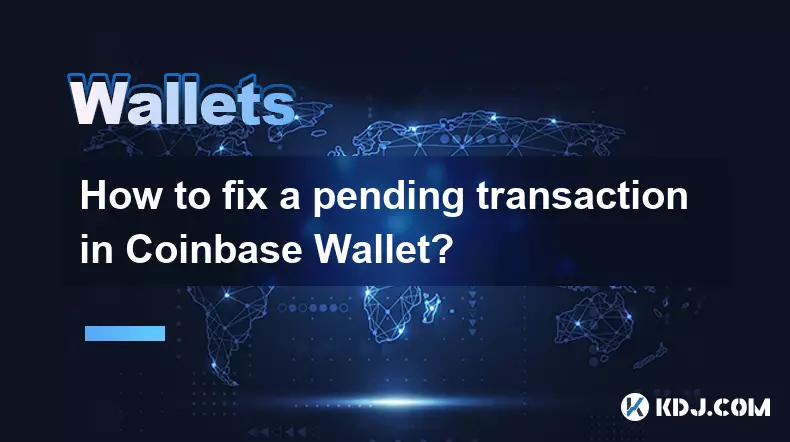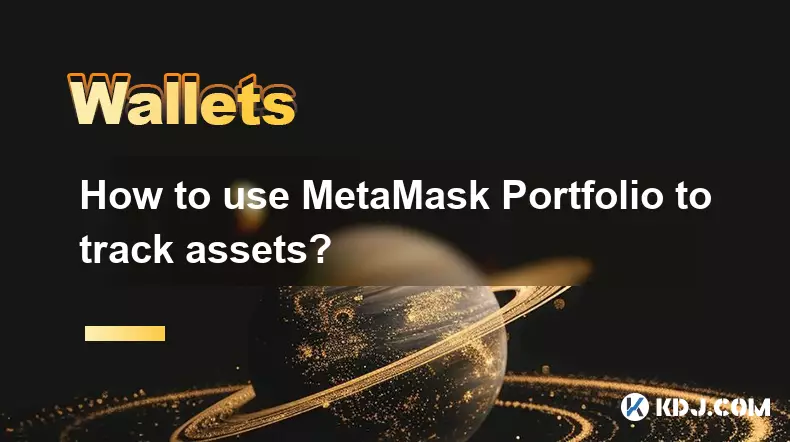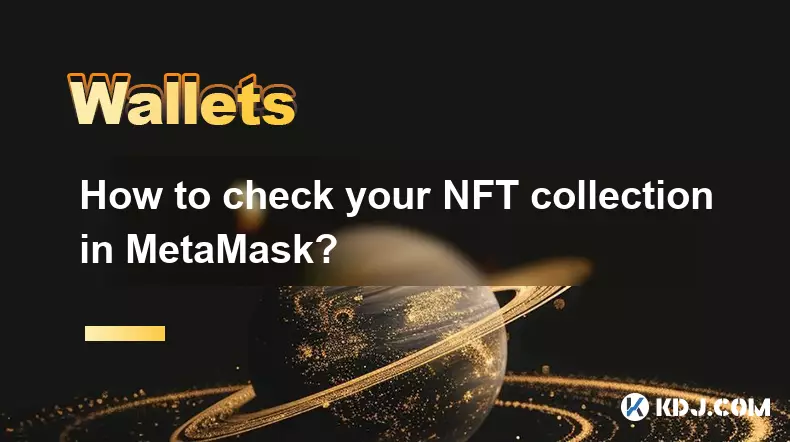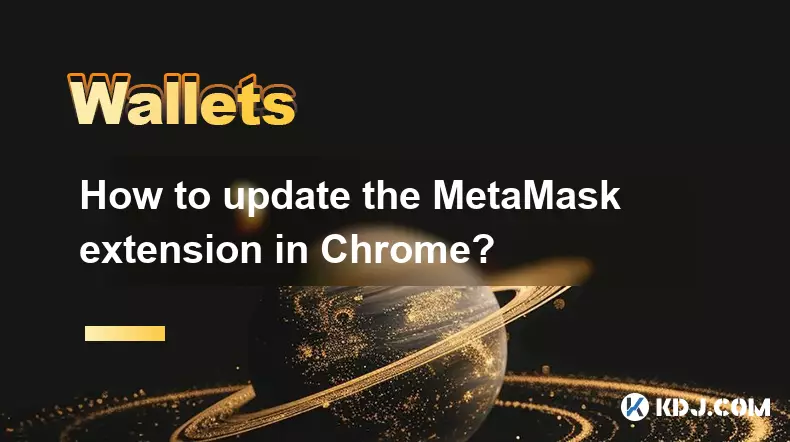-
 bitcoin
bitcoin $102877.190955 USD
1.88% -
 ethereum
ethereum $3430.435064 USD
4.52% -
 tether
tether $0.999264 USD
-0.05% -
 xrp
xrp $2.307310 USD
4.49% -
 bnb
bnb $987.740692 USD
3.82% -
 solana
solana $161.947760 USD
3.97% -
 usd-coin
usd-coin $0.999712 USD
-0.05% -
 tron
tron $0.292810 USD
2.93% -
 dogecoin
dogecoin $0.179738 USD
10.70% -
 cardano
cardano $0.580716 USD
8.75% -
 hyperliquid
hyperliquid $42.463448 USD
8.40% -
 chainlink
chainlink $15.763437 USD
7.05% -
 zcash
zcash $649.595636 USD
17.21% -
 bitcoin-cash
bitcoin-cash $511.610261 USD
7.19% -
 stellar
stellar $0.292537 USD
7.91%
How to fix a pending transaction in Coinbase Wallet?
A pending transaction in Coinbase Wallet means it's queued for blockchain confirmation, often delayed by low gas fees or network congestion.
Nov 06, 2025 at 12:59 am

Understanding Pending Transactions in Coinbase Wallet
1. A pending transaction in Coinbase Wallet occurs when a transfer of cryptocurrency has been initiated but not yet confirmed on the blockchain. This status means the network is processing the transaction, and it remains in a queue until miners or validators include it in a block. The most common reason for delays is network congestion, especially during periods of high activity on blockchains like Ethereum.
2. Each transaction requires a gas fee, which acts as an incentive for miners to prioritize it. If the fee attached to your transaction is too low compared to current market rates, it may sit in the mempool indefinitely. Users often set custom fees without realizing how much is necessary for timely confirmation, leading to extended wait times.
3. It’s important to recognize that once a transaction is broadcasted to the network, it cannot be canceled directly from the wallet interface. The decentralized nature of blockchain means control shifts from the user to the network after submission. Attempts to resend or duplicate the transaction without proper handling can result in complications such as double spending risks or stuck funds.
How to Speed Up a Pending Transaction
1. Within Coinbase Wallet, navigate to the transaction history and locate the pending transaction. Tap on it to view detailed information including the nonce, gas price, and hash. This data is essential for troubleshooting and potential resolution steps.
2. Use the “Speed Up” feature if available. This option allows you to rebroadcast the same transaction with a higher gas fee. The wallet creates a new transaction with the same nonce but increases the gas price, effectively replacing the original one in the mempool. Miners typically pick up the version with the higher fee, confirming it first.
3. Ensure your internet connection is stable and that the app is updated to the latest version. Outdated software may not properly communicate with node providers, causing display issues where transactions appear stuck even though they’ve been confirmed.
4. Monitor the transaction using a blockchain explorer like Etherscan. Enter the transaction hash to see real-time updates. If the status changes to 'confirmed,' the issue was likely visual and related to syncing within the wallet interface.
What to Do If Speed Up Fails
1. When the Speed Up function does not resolve the issue, consider using the “Cancel” option. This sends a zero-value transaction to yourself with the same nonce but a significantly higher gas fee. Successfully mining this replacement transaction nullifies the original pending one.
2. Constructing a cancellation transaction requires technical precision. You must manually set the gas limit and ensure the nonce matches the stuck transaction exactly. Incorrect input could lead to multiple failed attempts or unintended spending.
3. Some third-party tools integrate with Coinbase Wallet via WalletConnect, offering advanced transaction management features. Platforms like MetaMask or Rabby allow importing accounts and provide more granular control over pending transactions, though caution is advised when connecting external services.
4. Contact Coinbase support only if the transaction never broadcasted or if funds are missing from the balance entirely. Support teams cannot influence blockchain confirmations but can verify whether the transaction originated from their infrastructure.
Preventing Future Delays
1. Always review the recommended gas fees before confirming any transaction. Most wallets display estimated completion times based on different fee levels. Choosing a medium to high fee during peak hours reduces the likelihood of delays.
2. Enable automatic fee suggestions rather than setting custom values unless you have specific requirements. These dynamic recommendations adjust according to real-time network conditions, improving chances of prompt confirmation.
3. Avoid initiating multiple transactions in quick succession. Each subsequent transfer must use an incremented nonce. Queued transactions with lower nonces will block those behind them, creating a bottleneck effect.
4. Regularly clear outdated pending entries by completing or replacing them. Accumulated unconfirmed transactions can confuse users and interfere with accurate balance tracking across decentralized applications.
Frequently Asked Questions
Can a pending transaction stay pending forever?Yes, technically a transaction can remain pending indefinitely if the gas fee is too low to attract miner attention. Eventually, some nodes may drop it from the mempool, but there's no guaranteed timeline. Using the Speed Up or Cancel functions resolves this scenario.
Does restarting the Coinbase Wallet app help clear pending transactions?Restarting the app might refresh the interface and update the transaction status, especially if the delay is due to syncing issues. However, it won’t alter the blockchain state or accelerate confirmation of a low-fee transaction.
Will updating the Coinbase Wallet fix stuck transactions?An update ensures compatibility with current network protocols and improves performance. While it won't directly confirm a stuck transaction, running the latest version provides access to updated tools like improved Speed Up functionality and better error reporting.
Can I recover funds from a permanently stuck transaction?Funds are not lost; they remain in the sender’s control until the transaction confirms. If replaced successfully via a higher-fee transaction, the original amount returns to the wallet. As long as the private keys are secure, the assets remain accessible.
Disclaimer:info@kdj.com
The information provided is not trading advice. kdj.com does not assume any responsibility for any investments made based on the information provided in this article. Cryptocurrencies are highly volatile and it is highly recommended that you invest with caution after thorough research!
If you believe that the content used on this website infringes your copyright, please contact us immediately (info@kdj.com) and we will delete it promptly.
- Ripple (XRP) in 2026: Hold or Fold? A Look at XRP's Future and Emerging DeFi Alternatives
- 2025-11-08 18:35:01
- Zcash ZEC Coin Price Explosion: From Privacy Niche to Center Stage
- 2025-11-08 18:55:01
- Berachain Price Prediction: Navigating the Honeycomb Hype in Crypto
- 2025-11-08 18:55:01
- Arthur Hayes, Gold, and Bitcoin: A Modern Monetary Trinity?
- 2025-11-08 19:15:01
- Shiba Inu's Next Move: Navigating a Shifting Market
- 2025-11-08 19:20:01
- Pakistan's Crypto Crossroads: Balancing Opportunity with Asset-Backed Realities
- 2025-11-08 19:20:01
Related knowledge

How to use MetaMask Portfolio to track assets?
Nov 08,2025 at 05:40am
Getting Started with MetaMask Portfolio1. Download and install the MetaMask mobile app from the App Store or Google Play. Open the app and select 'Imp...

How to check your NFT collection in MetaMask?
Nov 06,2025 at 08:20pm
Accessing Your NFTs in MetaMask Wallet1. Open the MetaMask browser extension or mobile app and ensure you are logged into your wallet account. Once in...

Why is the MetaMask swap feature failing?
Nov 06,2025 at 09:20pm
Understanding MetaMask Swap FailuresMetaMask, one of the most widely used cryptocurrency wallets, enables users to swap tokens directly within the int...

How to update the MetaMask extension in Chrome?
Nov 08,2025 at 07:39am
Updating the MetaMask extension in Chrome is a simple process that ensures you have access to the latest security features, performance improvements, ...

How to import an account into MetaMask using a private key?
Nov 07,2025 at 07:40am
Importing an Account into MetaMask with a Private KeyMetaMask is one of the most widely used cryptocurrency wallets, particularly within decentralized...

What to do if my MetaMask wallet was compromised?
Nov 06,2025 at 04:59pm
Immediate Steps to Take After a Compromised MetaMask Wallet1. Disconnect your device from any phishing websites immediately. If you clicked on a suspi...

How to use MetaMask Portfolio to track assets?
Nov 08,2025 at 05:40am
Getting Started with MetaMask Portfolio1. Download and install the MetaMask mobile app from the App Store or Google Play. Open the app and select 'Imp...

How to check your NFT collection in MetaMask?
Nov 06,2025 at 08:20pm
Accessing Your NFTs in MetaMask Wallet1. Open the MetaMask browser extension or mobile app and ensure you are logged into your wallet account. Once in...

Why is the MetaMask swap feature failing?
Nov 06,2025 at 09:20pm
Understanding MetaMask Swap FailuresMetaMask, one of the most widely used cryptocurrency wallets, enables users to swap tokens directly within the int...

How to update the MetaMask extension in Chrome?
Nov 08,2025 at 07:39am
Updating the MetaMask extension in Chrome is a simple process that ensures you have access to the latest security features, performance improvements, ...

How to import an account into MetaMask using a private key?
Nov 07,2025 at 07:40am
Importing an Account into MetaMask with a Private KeyMetaMask is one of the most widely used cryptocurrency wallets, particularly within decentralized...

What to do if my MetaMask wallet was compromised?
Nov 06,2025 at 04:59pm
Immediate Steps to Take After a Compromised MetaMask Wallet1. Disconnect your device from any phishing websites immediately. If you clicked on a suspi...
See all articles





















![The Graph Price Prediction [GRT Crypto Price News Today] The Graph Price Prediction [GRT Crypto Price News Today]](/uploads/2025/11/07/cryptocurrencies-news/videos/690d4df44fe69_image_500_375.webp)



















































